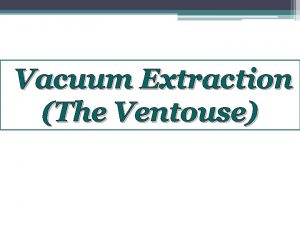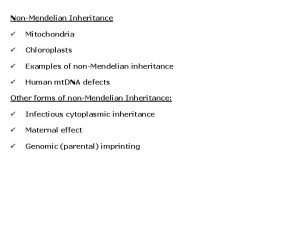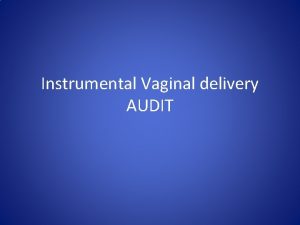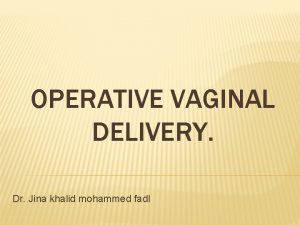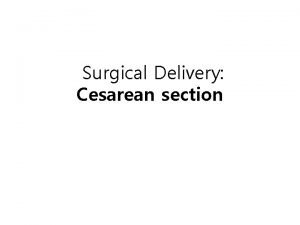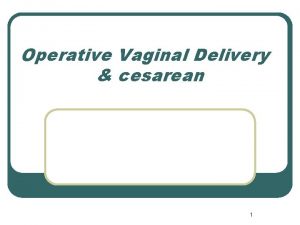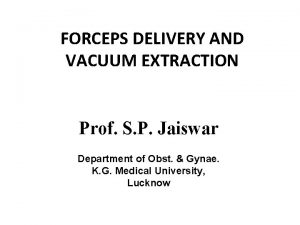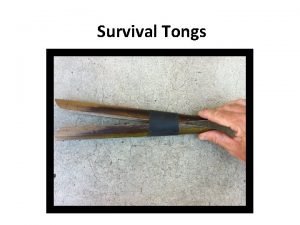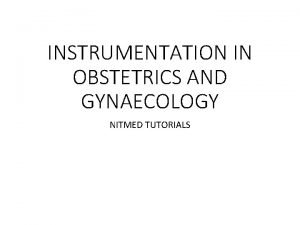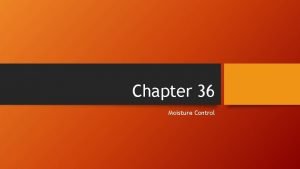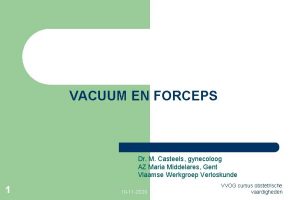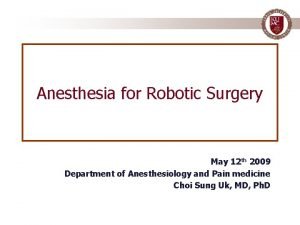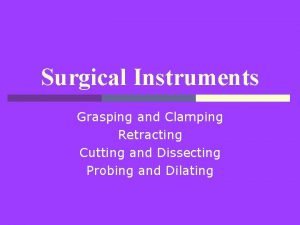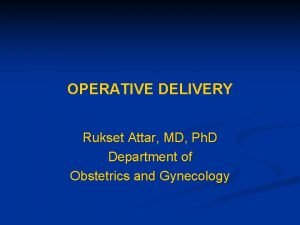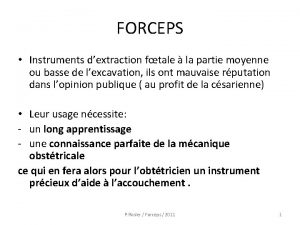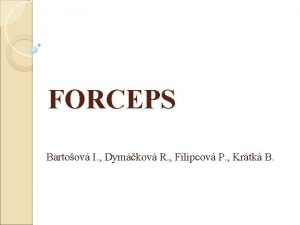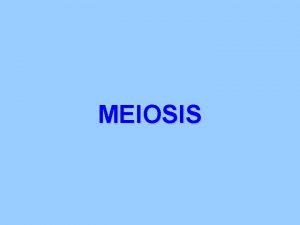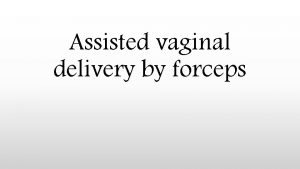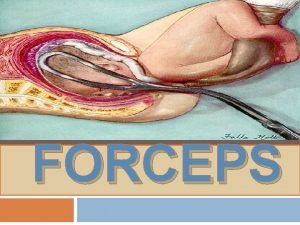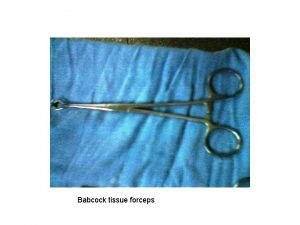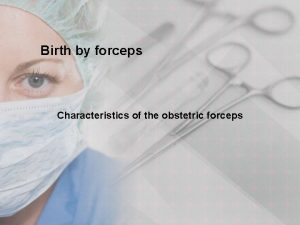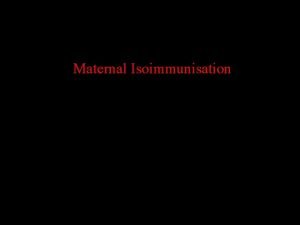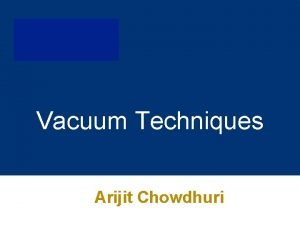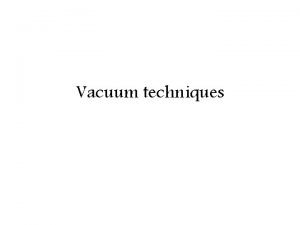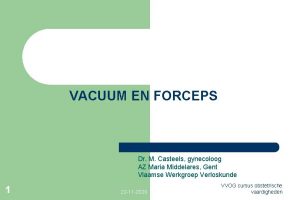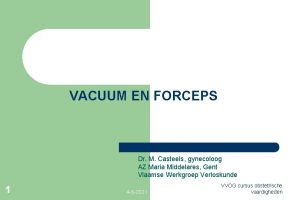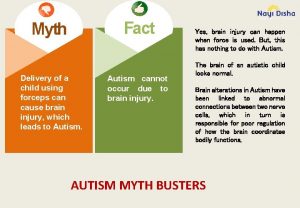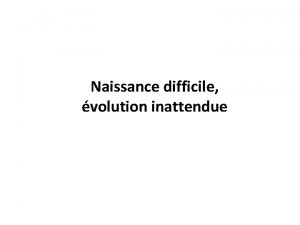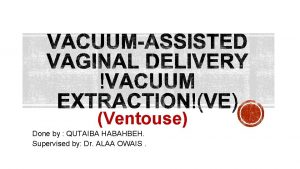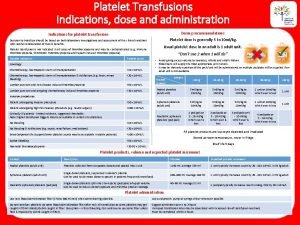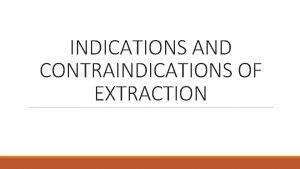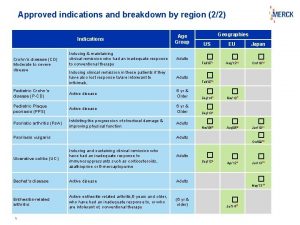Ventose and Forceps delivery Vacuum ventouse Indications MATERNAL


























- Slides: 26

Ventose and Forceps delivery

Vacuum /ventouse

Indications MATERNAL Exhaustion Prolonged second stage Cardiac / pulmonary disease FETAL Failure of the fetal head to rotate Fetal distress Should not be used for preterm, face presentation or breech

MNEMONIC A – Anesthesia adequate appropriate positioning & access B – Bladder cathterization C – Cervix fully dilated / membranes ruptured D – Determine position, station, pelvic adequacy

E – Equipment inspect vacuum cup, pump, tubing, check pressure

F – Fontanelle position the cup over the posterior fontan -ve pressure ↑ 10 cm H 2 O initially & between cont sweep finger around cup to clear maternal tissue ↑ pressure to 60 cm H 2 O with the next contraction

G – Gentle traction pull with contractions only\ traction in the axis of the births canal ask the mother to push during cont

H – Halt halt traction if no progress with three traction aided contractions vacuum pops off three times pulling for 30 min without significant progress

I – Incision consider episiotomy if laceration imminent J – Jaw remove vacuum when jaw is reachable or delivery assured

Steps of ventose application

11

Complications Vacuum –assisted delivery is less traumatic to the mother & fetus than forceps Ventouse should be the instrument of choice Maternal Vaginal laceration due to entrapment of vaginal mucosa between suction cup & fetal head

Fetal complications Scalp injuries chignon abrasion & lacerations 12. 6% scalp necrosis 0. 25 -1. 8% Cephalohematoma 25% jaundice /anemia Intracranial hemorrhage 2. 5% Subgaleal hematoma

Fetal complications Birth asphyxia 2. 6 -12% related to extraction force & time Some studies showed decrease birth asphyxia Retinal hemorrhage Forceps SVD Neonatal jaundice 50% 31% 19%

FORCEPS

Indications MATERNAL Exhaustion Prolonged second stage Cardiac / pulmonary disease FETAL Failure of the fetal head to rotate Fetal distress Control of the fetal head in vaginal beech delivery

Classification of forceps delivery Outlet forceps Scalp visible at the vulva without separating the labia Low forceps Midforceps Vertex at +2 station Head is engaged but leading part above +2 station Sagittal suture not in the AP plane of the mother

Classification Of Forceps Delivery Outlet Wrigley’s Outlet & low forceps Simpson /Elliot Midforceps & outlet Tucker Mclane Midforceps & rotation Kielland After coming head in breech Piper

After coming head in breech Piper

MNEMONIC A – Anesthesia adequate /epidural or pudendal appropriate positioning & access B – Bladder cathterization C – Cervix fully dilated / membranes ruptured D – Determine position, station, pelvic adequacy E – Equipment complete working forceps anesthesia support

F – Forceps phantom application Lt blade , LT hand, maternal Lt side pencil grip & vertical insertion with Rt thumb directing blade Rt blade , RT hand, maternal Rt side pencil grip & vertical insertion with Lt thumb directing blade Lock blades

Check application: Ø Post fontanelle 1 cm above the plane of the shanks Ø Sagittal suture lies in the midline of the shanks /perpindicular to the plane of the shanks Ø The operator can not place more than a fingertip between the fenestration of the blade & the fetal head on either side

G – Gentle traction applied with contraction & maternal expulsive efforts H – Handle elevated traction in the axis of the birth canal do not elevate handle to early

I – Incision consider episiotomy if laceration imminent J – Jaw remove forceps when jaw is reachable or delivery assured

Complications Maternal trauma to soft tissue 3 rd/4 th degree double the risk compared to ventouse bleeding from lacerations trauma to urethra & bladder fistula Pain 17% ventouse 11%

Complications Fetal bruising & laceration to the face Injury to the fetal scalp cephalohematoma 9% Vent 25% retinal hemorrhage 30% Vent 50% skull fracture permanent nerve damage / Facial nerve
 Vacuum extraction definition
Vacuum extraction definition Non nuclear inheritance
Non nuclear inheritance Extranuclear inheritance
Extranuclear inheritance Indication of forceps delivery
Indication of forceps delivery Forceps delivery types
Forceps delivery types Forceps indication mnemonic
Forceps indication mnemonic Mnemonic forceps delivery
Mnemonic forceps delivery Types of cesarean section
Types of cesarean section Indication of vacuum delivery
Indication of vacuum delivery Indication of forceps delivery
Indication of forceps delivery Tongs vs forceps
Tongs vs forceps Burlisher forceps
Burlisher forceps Ovum forceps parts
Ovum forceps parts Chapter 36 moisture control
Chapter 36 moisture control Metz vs mayo scissors
Metz vs mayo scissors Forceps piper
Forceps piper Cystolithotomy forceps
Cystolithotomy forceps Probing and dilating instruments
Probing and dilating instruments Magillis forceps
Magillis forceps Babcock tissue forceps uses
Babcock tissue forceps uses Rukset attar
Rukset attar Ftale
Ftale Filter forceps
Filter forceps Potts elevator technique
Potts elevator technique Breus forceps
Breus forceps National program related to children
National program related to children Difference between maternal and paternal chromosomes
Difference between maternal and paternal chromosomes
